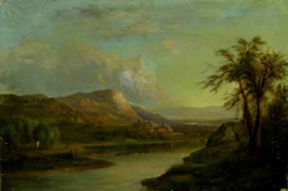
CINCINNATI – On the surface, there was nothing remarkable about the dingy, dirty canvas that arrived at Doug Eisele’s Old World Restorations for a cleaning in March of this year. The owner of the painting, a dentist from London, Ky., had purchased the artwork for $900 from an antique shop in Lexington, Ky., and felt it would benefit from a once-over from the expert restorers in Cincinnat
When Doug Eisele saw the painting he remarked, “That’s a nice painting,” which turned out to be an understatement of some magnitude. He thought the work looked vaguely familiar, but he couldn’t see a signature. As the cleaning progressed, the letters “…son” emerged from the right corner, and Eisele knew he was looking at a previously unknown work by Cincinnati artist and resident Robert Scott Duncanson (African-American/Canadian, 1821-1872). He immediately called the owner, suggesting he insure the painting for at least $100,000 – an estimated value Eisele would later increase to the $300,000 range.
Eisele was familiar with Duncanson’s work, having seen his eight mural works on exhibit at Cincinnati’s Taft Museum (formerly known as the Belmont), the home of Nicholas Longworth, who commissioned the work in 1851. He also had previously restored several Duncanson works.
Born in Fayette, N.Y, Duncason was the son of a Scottish-Canadian father and an African-American mother, which made him a “free-born person of color.” He was raised in Canada by his father to avoid racial conflicts, returning to the United States in 1841. He became a self-taught artist by copying prints and painting portraits. Seeking more commissions, he set up a studio in Detroit in 1845 but returned to Cincinnati in 1846 and focused on landscapes of the Ohio River Valley inspired by works of the Hudson River School. By the early 1850s he was a recognized landscape artist.
Duncanson became associated with the abolitionist movement in 1848 through a commission by Charles Avery, an abolitionist Methodist minister, which established him within a network of abolitionist patrons for the rest of his life. He is considered to be the first African-American to make a living selling art.
Duncanson was noted for painting partly from real life and partly from imagination. Eisele feels this is the case with the work brought in for restoration. He believes the painting is a combination of the White Mountains of New Hampshire in the Hudson River School style and an unidentified European landscape.
But before he could make that judgment, Eisele had to see enough of the painting to identify it, and that took considerable restorative skills. The first task was to remove the layers of smoke, soot, dust and dirt that had accumulated on the surface over the last 140 years. Then the original overlayer of yellowed damar varnish needed to be removed. As that process evolved, the green sky began to revert to blue, but it revealed that significant overpainting had been done at some point during a previous restoration. When the overpainting was removed, using all reversible procedures, the sky returned to its original hue. Old World’s inch-by-inch restoration took nearly eight weeks to complete, but the result was worth the wait.
The owner of the restored Duncnason has placed the work on long-term loan to the Speed Art Museum in Louisville, Ky., where chief curator Ruth Cloudman said, “It’s a fantastical landscape. When the opportunity came up to have one of his paintings on extended loan we knew that would be very exciting.”
Old World Restorations has been in the art conservation and restoration business since 1978. To contact them, call 513-271-5459 or e-mail deisele@oldworldrestorations.com. Visit them online at www.oldworldrestorations.com.
# # #
ADDITIONAL IMAGES OF NOTE



